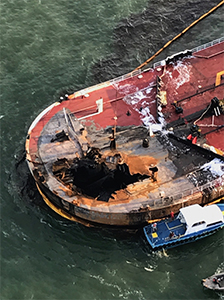Lonnie Roberts watched from the wheelhouse of the tugboat Buster Bouchard as blue flames surrounded two workers on the deck of barge B. No. 255. Moments later, the barge’s bow exploded.
“I didn’t understand it. I didn’t know what was happening,” Roberts, the former mate on the articulated tug-barge, told U.S. Coast Guard and National Transportation Safety Board (NTSB) investigators during a July hearing in Houston, Texas.
“There was an initial blast and then another blast, and at that point I was hearing blasts every second,” he said.
The incident occurred at about 0430 on Oct. 20, 2017, roughly three miles from Port Aransas, Texas. Du’Jour Vanterpool, 26, of Houston, and Zachariah Jackson, 28, of Salt Lake City, died in the accident. Six other crewmembers were not injured.
Nearly two dozen people testified during the formal Coast Guard hearing, which began July 16 and concluded July 27. Former Bouchard Transportation employees described a lax safety culture, poor vessel conditions, unchecked maintenance and fear of reprisals for reporting safety problems.
“The safety of the crew should come before dollar signs,” another former Buster Bouchard crewmember, assistant engineer Timothy Lerette, told investigators. “When something is reported by the captain or crew, clearly it is important enough to be addressed.”
Both the Coast Guard and NTSB are continuing to investigate the incident and have not yet determined a cause.
Buster Bouchard and B. No. 255 were preparing to get underway from an anchorage near Port Aransas when the incident occurred. The barge was carrying 140,000 barrels of crude oil. Vanderpool and Jackson were trying to haul in the anchor when the first blast occurred on the port bow, throwing both men into the water.
During the chaotic minutes that followed, the tug’s crew struggled to release towing pins linking the two vessels. A crewman climbed onto the barge to release a bow line as explosions raged. Once free from the burning vessel, Buster Bouchard circled the barge in search of survivors.
After the sun rose, Lerette and another crewman boarded a pilot boat whose operator spotted floating remains. As the vessel approached, Lerette recognized Vanterpool.
“We saw him roll over and saw his face and knew right away it was Du’Jour,” Lerette said through tears. “We tried to retrieve him but he slipped out of the life jacket and sank down to the bottom.”
Later, Lerette recovered charred footwear belonging to both men. Vanterpool’s boots were stained with blood.
The 38-year-old Buster Bouchard reportedly had numerous mechanical issues in the weeks leading up to the explosion. According to Lerette, the 6,140-hp tug had a slow fuel leak into the aft steering space on the voyage, and an oil cooler that needed to be replaced. Those repairs were slated to occur after offloading crude in Corpus Christi.
Problems also were cited with B. No. 255. Jackson was reprimanded by a company executive for reporting problems with the vessel, Lerette said. He also testified that Jackson called an off-duty Bouchard crewman seeking detailed instructions for venting vapors from the barge on the night before the explosion.
Lerette, a 2016 Maine Maritime Academy graduate, started working for Bouchard less than six months before the accident and reportedly was fired a short time afterward. He claimed the company never told him why.
At other points during the hearing, other Bouchard employees shared details about potential safety lapses involving other vessels.
Morgan Jackson, brother of accident victim Zachariah Jackson, reportedly got sick from exposure to gas vapors in May 2017 while working on B. No. 275. He claimed he reported the leak to management, which did not repair it by the time he was promoted to another vessel three months later.
Then on Nov. 7, 2017, a whistleblower aboard B. No. 275 contacted the Coast Guard to report a dangerous fuel vapor buildup. Former Coast Guard Cmdr. James Bigbe, who retired recently after leading Sector New Orleans’ prevention unit, said inspectors initially did not find any affected compartments.
Later that night, Bigbe testified, the whistleblower called again with specific instructions for finding the space, which was located aft on the port side. The next morning, the Coast Guard again boarded the vessel and found the space. Air sampling registered 28 percent on the lower explosive limit (LEL).
According to Bigbe, the tankerman recorded a reading of 100 percent LEL on Oct. 22 and reported it to management. Electrical components and other equipment were located in the compartment, where explosive readings were found as far back as May 2017.
Testifying about another incident, former Bouchard third mate Keith Hardwick said that Bouchard first captain Eric Hinman quit rather than depart from a Florida shipyard before barge repairs and testing were complete. Hardwick, who quit shortly after the B. No. 255 incident, claimed that Hinman was under pressure from Bouchard to depart from the shipyard to Houston.
Bouchard, based in Melville, N.Y., faces at least one lawsuit as a result of the fatal blast. The company issued a statement after the hearings indicating that it is cooperating with all requests for information about the incident, the operator’s safety procedures and its record of performance. It also emphasized the importance of safety in company culture.
“We are profoundly saddened by the tragic loss of our two fellow crewmembers in this incident,” company spokeswoman Danielle Bouchard said. “It is critical to us that we closely examine every aspect of this tragedy and learn everything we can to prevent an accident like this from ever happening again.”
“What is clear is that no evidence was uncovered in these hearings showing Bouchard to be at fault in the B. No. 255 explosion,” the statement added.
The Coast Guard and NTSB have not indicated when their final accident reports will be released.

